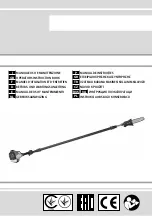
12
Fence Adjustment
2. Place the fence assembly onto the
guide
rail
(D, Fig. 9) and against the edge of the
miter
slot
(C, Fig. 9). The hook at the rear of the
fence should fit under the rear rail (see Figure
12).
The fence must align parallel to the miter slot along
the entire length of the fence.
If adjustment is necessary:
3. Lock the fence by pushing down the
lock
handle
(A, Fig. 9). Because the screws are only
hand-tight, you can shift the fence slightly as
needed until the fence is parallel the miter slot.
4. When the fence has been properly aligned to
the miter slot, tighten the four
socket head cap
screws
(B, Fig. 9) with a 6mm hex wrench.
Make sure the fence remains parallel to the
miter slot as you tighten the screws.
Note:
This alignment will again be checked
once the guide rail has been tightened.
5. Move the fence assembly to the other side of
the blade as shown in Figure 10 so that the
pointer
(B, Fig. 10) on the fence body points to
zero
on the scale. Lock the fence by pushing
the
handle
(A, Fig. 10) down.
6. Move the guide rail (D, Fig. 10)
with the locked
fence
until the fence is flush against the blade
(C, Fig. 10). Do not unlock the fence to perform
this. Move the fence and guide rail together
when establishing the zero point.
Important:
Do not force the fence into the
blade so that the blade bends.
7. With a 10mm wrench, tighten the five hex cap
screws located on the bottom of the front rail
that hold the guide rail to the front rail.
Note:
After tightening the guide rail, double
check that the fence is still parallel to the miter
slot. Make additional adjustments if needed.
Figure 9
Figure 10













































